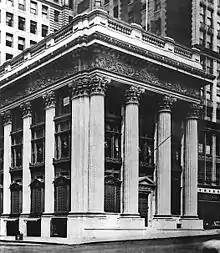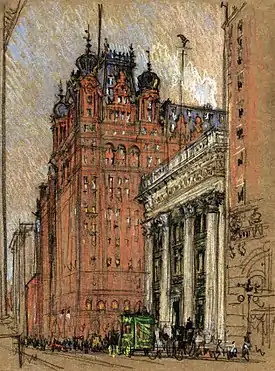Knickerbocker Trust Company
The Knickerbocker Trust was an American bank based in New York. It was at one time among the largest banks in the United States and it became a central player in the Panic of 1907.

History
The bank was chartered in 1884 by Frederick G. Eldridge, a friend and classmate of financier J.P. Morgan. As a trust company, its main business was serving as trustee for individuals, corporations and estates. Eldridge was the founding president; he was succeeded in the 1890s by Robert MacClay, with Charles Tracy Barney as vice president. When MacClay retired in 1897, Barney was elected president. The New York City bank was housed in a Roman-style temple designed by McKim, Mead, and White and erected between 1902 and 1904 (illustrated) at the northwest corner of 34th Street and Fifth Avenue.[1] Stanford White's design allowed for the possibility of adding nine storeys of offices upon the structure.[2] It had branch offices at 60 Broadway, in Harlem and The Bronx.
In 1907, its funds were being used by then-president Charles T. Barney in a plan to drive up the cost of copper by cornering the market. This gamble came undone due to the dumping of millions of dollars in copper into the market to stop a hostile takeover in an unrelated organization. This became public, and on October 21, 1907, the National Bank of Commerce announced that it would no longer accept checks for the Knickerbocker Trust Company, triggering a run of depositors demanding their funds back. Charles Barney requested a meeting with J.P. Morgan to discuss financial assistance for the bank, but was rejected. Shortly after, he shot himself on November 14, 1907.

The resulting Panic of 1907 exacerbated an ongoing decline in the stock market that saw the Dow Jones Industrial Average lose 48% of its value from January 1906 to November 1907. The banking crisis is also seen as the final straw that led Congress to form the Federal Reserve System in 1913.
The company reopened some weeks after its forced closing and paid off all depositors in full with interest. In 1912, its assets were acquired by the Columbia Trust Company, forming the Columbia-Knickerbocker Trust Company. This entity was acquired by the Irving Trust Corporation in 1923, which was in turn acquired by the Bank of New York in 1989.
The building was enlarged by ten stories in 1921, and the façade completely redesigned in 1958, with its signature pilasters covered over; it still remains, its original form unrecognizable.[3]
Notes
- The marble mansion of the dry-goods magnate A.T. Stewart, first of the grandiose palaces on Fifth Avenue, was demolished to make way for it.
- Digital Metro New York: Knickerbocker Trust Company, 1910 photograph.
- Gray, Christopher (March 5, 2009). "Streetscapes: Fifth Avenue and 34th Street: Stanford White's Backdrop for the Panic of 1907". The New York Times. Retrieved 2009-03-06.
Sources
- John Steele Gordon. (1999), The Great Game: The Emergence of Wall Street as a World Power: 1653–2000.
- Edward Ten Broeck Perine. (1916), The Story of the Trust Companies.